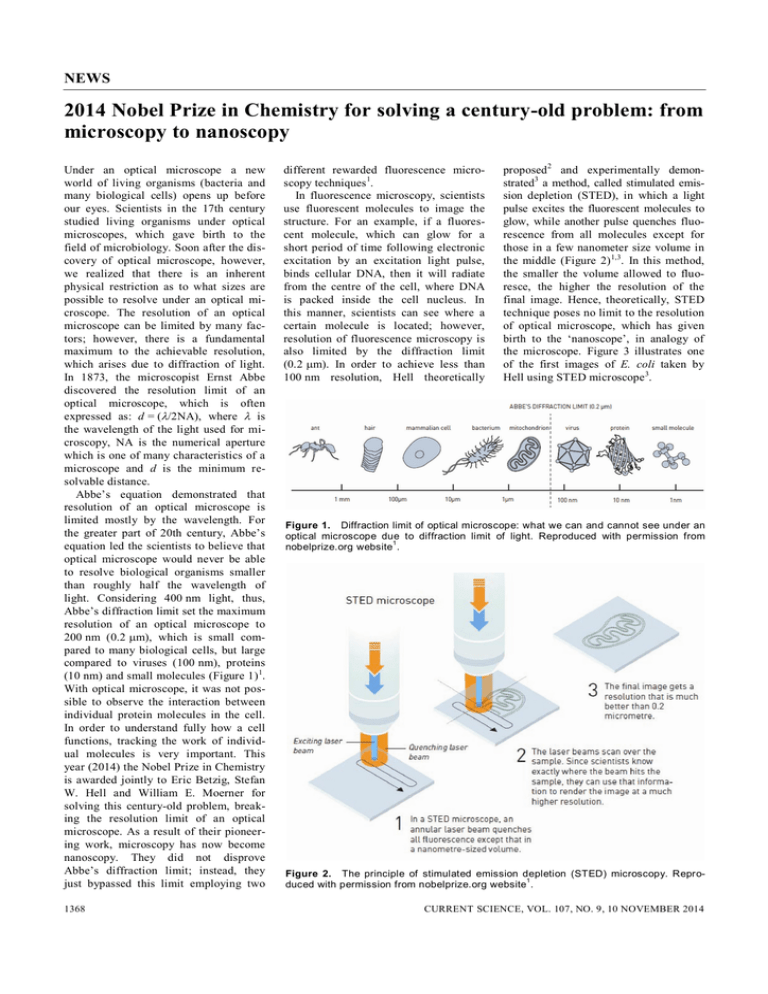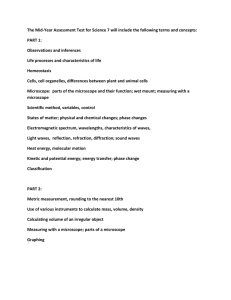2014 Nobel Prize in Chemistry for solving a century-old problem:... microscopy to nanoscopy NEWS
advertisement

NEWS 2014 Nobel Prize in Chemistry for solving a century-old problem: from microscopy to nanoscopy Under an optical microscope a new world of living organisms (bacteria and many biological cells) opens up before our eyes. Scientists in the 17th century studied living organisms under optical microscopes, which gave birth to the field of microbiology. Soon after the discovery of optical microscope, however, we realized that there is an inherent physical restriction as to what sizes are possible to resolve under an optical microscope. The resolution of an optical microscope can be limited by many factors; however, there is a fundamental maximum to the achievable resolution, which arises due to diffraction of light. In 1873, the microscopist Ernst Abbe discovered the resolution limit of an optical microscope, which is often expressed as: d = (/2NA), where is the wavelength of the light used for microscopy, NA is the numerical aperture which is one of many characteristics of a microscope and d is the minimum resolvable distance. Abbe’s equation demonstrated that resolution of an optical microscope is limited mostly by the wavelength. For the greater part of 20th century, Abbe’s equation led the scientists to believe that optical microscope would never be able to resolve biological organisms smaller than roughly half the wavelength of light. Considering 400 nm light, thus, Abbe’s diffraction limit set the maximum resolution of an optical microscope to 200 nm (0.2 m), which is small compared to many biological cells, but large compared to viruses (100 nm), proteins (10 nm) and small molecules (Figure 1) 1. With optical microscope, it was not possible to observe the interaction between individual protein molecules in the cell. In order to understand fully how a cell functions, tracking the work of individual molecules is very important. This year (2014) the Nobel Prize in Chemistry is awarded jointly to Eric Betzig, Stefan W. Hell and William E. Moerner for solving this century-old problem, breaking the resolution limit of an optical microscope. As a result of their pioneering work, microscopy has now become nanoscopy. They did not disprove Abbe’s diffraction limit; instead, they just bypassed this limit employing two 1368 different rewarded fluorescence microscopy techniques 1. In fluorescence microscopy, scientists use fluorescent molecules to image the structure. For an example, if a fluorescent molecule, which can glow for a short period of time following electronic excitation by an excitation light pulse, binds cellular DNA, then it will radiate from the centre of the cell, where DNA is packed inside the cell nucleus. In this manner, scientists can see where a certain molecule is located; however, resolution of fluorescence microscopy is also limited by the diffraction limit (0.2 m). In order to achieve less than 100 nm resolution, Hell theoretically proposed2 and experimentally demonstrated3 a method, called stimulated emission depletion (STED), in which a light pulse excites the fluorescent molecules to glow, while another pulse quenches fluorescence from all molecules except for those in a few nanometer size volume in the middle (Figure 2) 1,3. In this method, the smaller the volume allowed to fluoresce, the higher the resolution of the final image. Hence, theoretically, STED technique poses no limit to the resolution of optical microscope, which has given birth to the ‘nanoscope’, in analogy of the microscope. Figure 3 illustrates one of the first images of E. coli taken by Hell using STED microscope 3. Figure 1. Diffraction limit of optical microscope: what we can and cannot see under an optical microscope due to diffraction limit of light. Reproduced with permission from 1 nobelprize.org website . Figure 2. The principle of stimulated emission depletion (STED) microscopy. Repro1 duced with permission from nobelprize.org website . CURRENT SCIENCE, VOL. 107, NO. 9, 10 NOVEMBER 2014 NEWS Figure 3. (Left) Image of an E. coli bacterium taken under conventional microscope. (Right) The same image taken using STED nanoscopy. STED image exhibits three 3 times better resolution. Reproduced with permission from Proc. Natl. Acad. Sci. USA . © 2000 National Academy of Sciences, USA. Figure 4. The principle of single molecule microscopy. Reproduced with permission 1 from nobelprize.org website . Figure 5. a, Image of lysosome membranes using conventional microscopy. b, The same image taken by single molecule microscopy. Reproduced with permission from 6 Science . When Hell was developing STED microscopy, Betzig and Moerner were also independently developing another technique based on single molecule microscopy, which could also bypass the diffraction limit of optical microscope. CURRENT SCIENCE, VOL. 107, NO. 9, 10 NOVEMBER 2014 Quite interestingly, single molecule microscopy was being built based on previously Nobel prize-awarded (2008) discovery of the green fluorescent protein (GFP). In 1997, Moerner discovered that the fluorescence of one variant of GFP could be turned on and off depending on the wavelength of the excitation light 4. By this discovery Moerner demonstrated that it was possible to optically control fluorescence of a single molecule. Inspired by Moerner’s work, Betzig, in 1995, theoretically proposed that optical microscope could bypass the diffraction limit if different molecules glow with different excitation wavelengths (i.e. different colours) 5. Idea behind this principle, as shown in Figure 4, was that if all the molecules of one colour stay separated (dispersed) by a distance more than 0.2 m (Abbe’s diffraction limit), their positions can be determined precisely under optical microscope. Next the microscope can register one image per colour. A complete image can then be constructed by superimposing the images from different coloured molecules, even if their intermolecular distance was a few nanometers. By this methodology, one could bypass Abbe’s diffraction limit. Furthermore, in principle, this methodology should work even if different fluorescent molecules are glowing at different times. It took several years for Betzig, however, to practically demonstrate his idea due to lack of available molecules with distinguishable optical properties. By 2005, he came across different single fluorescent proteins, similar to those that were detected by Moerner in 1997 at the level of a single molecule. Using these excitable florescent proteins as tools, Betzig was able to implement his idea of single molecule microscopy. Using a very weak light pulse he activated a particular type of fluorescent protein which was dispersed by a distance more than 0.2 m. Hence, position of each glowing protein was registered precisely in the microscope. After a while, when the florescence of these proteins died out, he activated another set of proteins to register the image. Here different groups of protein stay within a few nanometer distances, but molecules in the same group are separated by a distance more than 0.2 m. All the images taken by this methodology were then superimposed to obtain super resolution image, bypassing the diffraction limit. Figure 5 illustrates 1369 NEWS the first super resolution image taken by Betzig using single molecule microscopy6. The methods developed by Betzig, Hell and Moerner have started deciphering whole new levels of understanding of what goes on in the human body down to the nanoscale 1. Hell has looked inside living nerve cells in order to better understand brain synapses. Moerner has studied proteins involved in Huntington’s disease. Betzig has followed cell division inside embryos. These are just a few examples. Undoubtedly, these exciting discoveries have emerged through painstaking years of research by them and through their intense passion to a century-old problem ‘how could Abbe’s diffraction limit be circumvented?’ This curious and passionate approach to science is an inspiration to all of us. 3. Klar, T. A., Jakobs, S., Dyba, M., Egner, A. and Hell, S. W., Proc. Natl. Acad. Sci. USA, 2000, 97, 8206–8210. 4. Dickson, R. M., Cubitt, A. B., Tsien, R. Y. and Moerner, W. E., Nature, 1997, 388, 355–358. 5. Betzig, E., Opt. Lett., 1995, 20, 237–239. 6. Betzig, E. et al., Science, 2006, 313, 1642– 1645. 1. http://www.nobelprize.org/nobel_prizes/ chemistry/laureates/2014/ 2. Hell, S. W. and Wichman, J., Opt. Lett., 1994, 19, 780–782. Atanu Bhattacharya, Inorganic and Physical Chemistry Department, Indian Institute of Science, Bangalore 560 012, India. e-mail: atanub@ipc.iisc.ernet.in MEETING REPORT Bio-security in agriculture* Bio-security in agriculture deals with managing biological risks associated with crop and animal husbandry. As this is an emerging global concern, it necessitates countries to establish bio-security systems, either to meet obligations under international agreements or take advantage of opportunities in trade. Considering the importance of biological risks in agriculture that India faces, a brainstorming session was held recently. The meeting was chaired by the chief guest K. Satyagopal (National Institute of Plant Health Management (NIPHM), Hyderabad). During the occasion those involved in the management of alien invasive, the eucalyptus gall wasp (Leptocybe invasa) were honoured. The success of the eucalyptus wasp management programme stemmed from coordinated efforts of Indian Forest Genetics and Tree Breeding (IFGTB), Coimbatore, ICAR-National Bureau of Agricultural Insect Resources (ICAR-NBAIR), Bengaluru and ITC. N. Bakthavatsalam and A. N. Shylesha (ICAR-NBAIR), John Prashanth Jacob (IFGTB) and H. D. Kulkarni (Indian Paper Manufacturing Association) were honoured for their contributions. The theme of the meeting was introduced by Abraham Verghese (ICARNBAIR). In his opening remarks, the *A report on a brainstorming session on ‘Biosecurity issues in relation to insects and quarantine’ held on 26 August 2014 at ICARNational Bureau of Agricultural Insect Resources, Bengaluru. 1370 Guest of Honour, S. N. Sushil (Plant Protection Advisor, New Delhi) highlighted the importance of bio-security in India considering its vast geographical area and vast coast line (7577 km) with 68 notified entry points. He informed that incidence of introduced pests occurs as an initial outbreak followed by continuous chronic damage. Hence, emphasis has to be laid on management, mitigation, forewarning and regulatory mechanisms for invasives. He mentioned the amendments to Destructive Insect Pests Act in respect of invasions and clauses of the Biodiversity Act considering the need for bio-security. He called for a cohesive network comprising State Agricultural universities, ICAR institutes and developmental agencies concerned with plant protection and quarantine to regulate pest invasions and to draw up action plans to contain invasives. Satyagopal detailed the role of biocontrol agents in suppressing invasives in India, viz. coffee berry borer, potato tuber moth, spiralling whitefly, papaya mealybug, etc. The regulatory policies imposed by the Government, viz. the Biodiversity Act, bio-security analysis, management risks and Sanitary and Phytosanitary Certificate (SPC), 2003 (relating to plant bio-security) were detailed by him. He discussed the drawbacks and omissions in Bio-security Act relating to invasives and importation of natural enemies. He emphasized the need for analysis of looming threats and eradication before establishment, balancing nature and suppression by natural enemies. He mentioned that improving post-entry quarantine at the panchayat level may aid in creation of awareness. He was of the opinion that ecosystem analysis-based IPM apart from the economic threshold level (ETL)-based IPM was necessary to have better information, understanding and visibility. Capacity building in sanitation and phytosanitation measures were essential to address effectively the issues related to bio-security. The technical session on issues related to insect taxonomic research was chaired by C. A. Viraktamath (UAS, GKVK, Bengaluru). J. Poorani (ICAR-NBAIR) delivered a talk on ‘Legislative obstacles to insect taxonomic research – a potential threat to India’s bio-security’. The relation between taxonomy and bio-security was discussed. With a wide geographical spread and biodiversity, only one-third of the insects in the country have been documented. The drawback is mainly due to shortage of manpower to carry out taxonomy related work and only 35% of the area in taxonomic research in India is addressed by the Zoological Society of India (ZSI). Identification services can be done at best, if taxonomists are permitted to exchange specimens at the international level. To overcome the hurdle in exchange of dead specimens between taxonomists of our country and experts from abroad, the guidelines of the Biodiversity Act have to be suitably modified to enable the exchange of specimens between repositories. Poorani also highlighted the existing gaps in the Biodiversity Act and guidelines that are difficult CURRENT SCIENCE, VOL. 107, NO. 9, 10 NOVEMBER 2014





